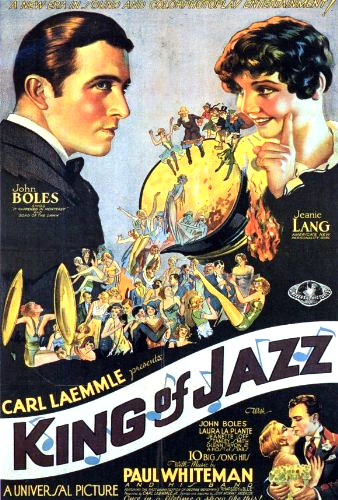While I’m sure that a good number of my readers will at least have heard of Lucille Ball, that may not be the case with Paul Whiteman. He’s the “king” in the King of Jazz, a 1930 multimillion-dollar musical extravaganza that makes Kevin Costner’s Waterworld seem unambitious. It also makes even less sense. This is the movie Federico Fellini might have made had he been born near 42nd street in Manhattan. By the time King of Jazz is over, you need a friend to help you pull your jaw up off the floor. Imagine the 12 days of Christmas gone completely wild: 20 bagpipers piping, 30 drummers drumming, 40 balalaika players a-playing, 50 sax players honking, and a grand piano as big as most music stores. Those of you who have watched the early Busby Berkeley musicals of the 1930s will have some idea of what I’m describing here. But even Busby Berkeley will not have prepared you for 98 minutes of trick photography, creative lighting, fake mechanical songbirds, bizarre 30-second comedy skits, amazingly synchronized chorus numbers by young women with two-colour Technicolor pink legs, Bing Crosby’s first screen appearances crooning with the Rhythm Boys, Marion Statler and Don Rose doing an insane dance number that even Brasseur & Eisler might think twice about trying, and giant production numbers including one with tenor John Boles leading a huge cowboy-clad chorus in a Halleluiah chorus as giant gates open to reveal the closest 1930s technology could get to a cosmic sunrise. ‘
And that’s just for starters. There’s a musical/comedy act that I’m certain must have been the inspiration for one of my favorite Cirque de Soleil routines, the Depression-era version of the Michael Jackson moonwalk, and a surrealistic little Betty Boop-style cartoon contributed by Walter (“Woody Woodpecker”) Lanz.
You want songs? Boy, have we got songs. How about Gershwin’s “Rhapsody in Blue”? Or the Monty Pythoncesque “Has Anybody Seen Our Nellie”? The touching “Ragamuffin Romeo”? Bing singing “Happy Feet” (“Happy feet/I’ve got those happy feet/Give them a low-down beat/And they begin daaaancing ….”)? As for the climax, in which we really learn that jazz represents “the melodies of all nations fused into one rhythm,” if the kitchen sink were a musical instrument I’m sure it would have been featured in there along with everything else. It might be there anyway.
The presiding genius over this madness, jovial Lou Costello look-alike Paul Whiteman, directs a 40-piece orchestra that includes everything from piccolos to banjoes. Run, don’t walk, down to your local video store.
Looking Back & Second Thoughts
Although the two-color Technicolor may have faded, and all we have left are lovely pastels, King of Jazz is still a perfect time machine. This is as close as any of us who weren’t born in the first half of the 20th century will ever get to experiencing the Vaudeville stage in its prime. That was the stage that gave us singing & dancing, the wildest physical comedy, ribald humor, big band tunes, and just about anything else that could be called entertainment. Even, towards the end, cinema itself. King of Jazz throws it all onscreen, amplified a hundredfold by a costume & prop budget that would have rivalled that of several small countries, clever camera effects, genuine talent, and the unfettered imaginations of Universal Pictures’ art directors, set designers, costumers, and choreographers. And I haven’t even mention the star of the picture. Orchestra leader Paul Whiteman led one of the most popular big bands of the 20s and early 30s. Duke Ellington wrote of him, “Paul Whiteman was known as the King of Jazz, and no one as yet has come near carrying that title with more certainty and dignity.” High praise, indeed, from an unimpeachable source.
Sure, some of the picture is cheesy and some of it’s annoying and some of it’s What the hell?, but it’s joyously lighthearted, you’re never going to guess what’s coming next, and every time you think you’ve hit the climax there’s an even bigger number waiting just around the bend. Of course, much of this has little if anything to do with jazz as I think of it—not the risqué opening cartoon by Walter Lantz (the first color sound cartoon), not the wedding gown extravaganza, not Bing Crosby and the Rhythm Boys, not the Mexican song about Old Monterrey, not the leggy chorines, not the petting in the public park, not the fish song, not—oh heck, you get my drift.
I have to believe that any surrealist watching this film for the first time would take days to recover from the shock. Hollywood could be surreal with the best of them. How else do you manage to squeeze Rhapsody in Blue, Happy Feet, a phalanx of Scottish bagpipers, and a stage set that the Nazis might have cribbed for their 193 Nuremberg rally into the same motion picture? Sentiment & absurdity in equal, walloping measures, delivered with gusto. There was a formula here, but no mad genius would ever mix the ingredients quite like this again. By 1934, the MPAA Production Code would be spoiling everyone’s party.

